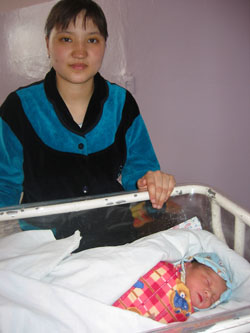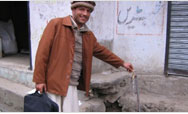You are here » Home » Telling Our Story
Success Story
Project teaches staff
to focus on the concerns of mother and child
Bringing a Human Touch to Maternity

Photo: ZdravPlus
A new curriculum being taught to health workers in Kazakhstan’s capital, Astana, emphasizes among other changes keeping newborns, such as this child, with their mother at all times.
“I can really see a difference between the old approaches and the new ... this feels right in my heart. Our outlook has been changed,” said Olga, an obstetrician at Astana’s Maternity Hospital #3.
A partnership for healthy motherhood in Astana is focusing on improving maternal and child health in Kazakhstan’s capital by shifting toward less medicalized, more woman-, child-, and family-centered, evidence-based prenatal care, delivery, and postpartum care.
USAID and ExxonMobil have jointly funded this project, the third public-private partnership in Astana, which the Kazakhstan Association of Family Physicians and USAID are implementing.
During the project’s first training, international instructors came to Astana to train local doctors on the World Health Organization’s (WHO) Safe Motherhood curriculum. A total of 36 participants — composed of practicing obstetricians and gynecologists, obstetrics instructors from the medical university, neonatologists, and midwives — completed the course. The WHO methods call for fewer pre-natal visits, clean birth (which means that women can have partners with them during labor and delivery) as opposed to sterile birth, letting women choose their own positions, and keeping the newborn with their mother at all times, among other non-medical interventions.
According to Olga, a young obstetrician at Maternity Hospital #3, the women who are delivering with the Safe Motherhood approaches in place have been extremely satisfied with the experience. “Though I have been working as a doctor for only four years,” she said, “I can really see a difference between the old approaches and the new ... this feels right in my heart. Our outlook has been changed.”
In addition to training providers on how to work with expectant couples and address concerns such as nutrition, relaxation techniques for labor and delivery, and family planning, the project also established and equipped prenatal preparation schools at two facilities in Astana, including Olga’s. She said the best thing about the course was that it provided concrete steps the providers can follow in running the classes for the general public.
Print-friendly version of this page (533kb - PDF)
Click here for high-res photo
Back to Top ^ | 

